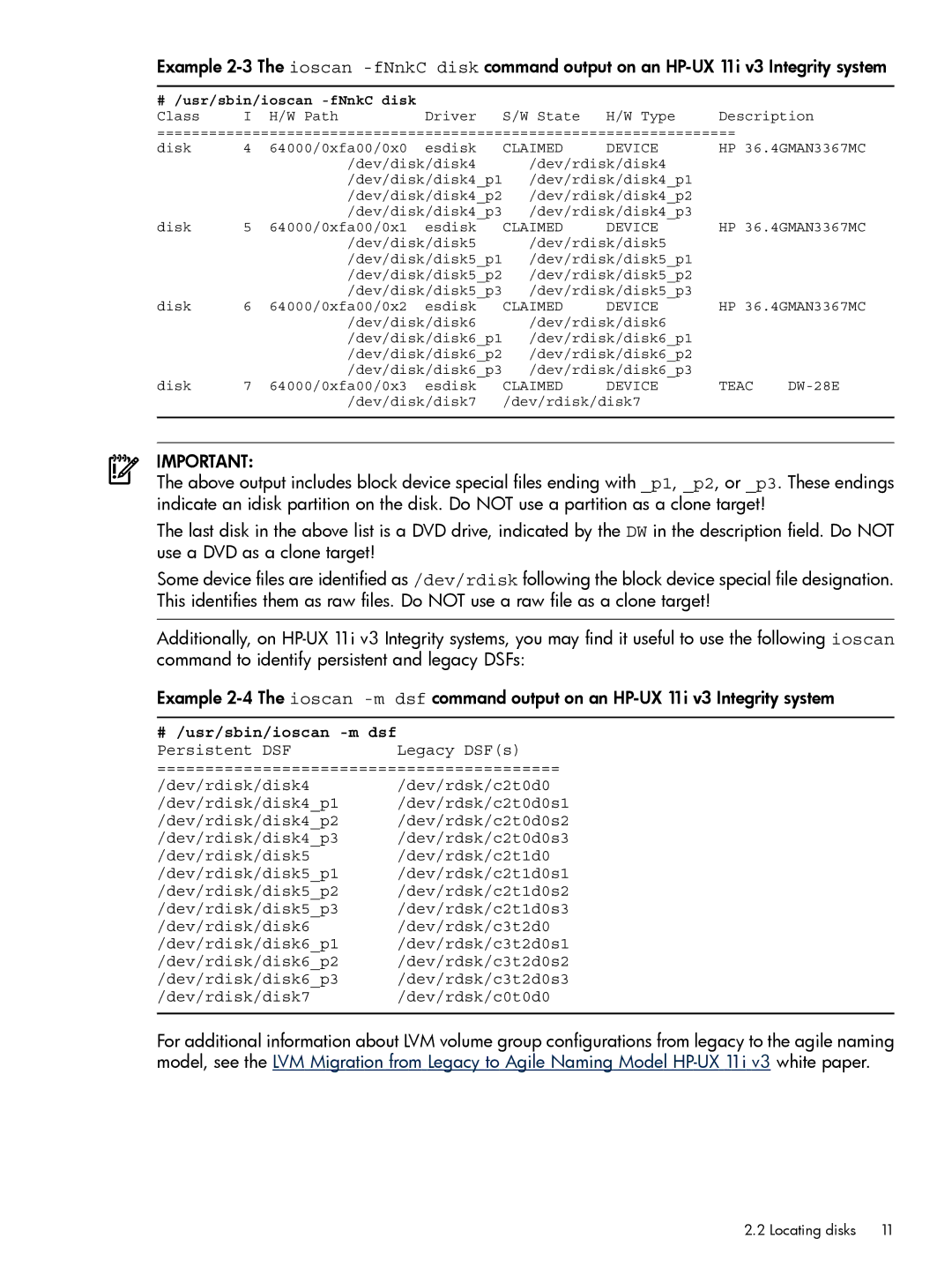
Example
# /usr/sbin/ioscan |
|
|
|
|
| ||
Class | I | H/W Path | Driver | S/W State | H/W Type | Description | |
=================================================================== |
| ||||||
disk | 4 | 64000/0xfa00/0x0 | esdisk | CLAIMED | DEVICE | HP 36.4GMAN3367MC | |
|
| /dev/disk/disk4 | /dev/rdisk/disk4 |
|
| ||
|
| /dev/disk/disk4_p1 | /dev/rdisk/disk4_p1 |
|
| ||
|
| /dev/disk/disk4_p2 | /dev/rdisk/disk4_p2 |
|
| ||
|
| /dev/disk/disk4_p3 | /dev/rdisk/disk4_p3 |
|
| ||
disk | 5 | 64000/0xfa00/0x1 | esdisk | CLAIMED | DEVICE | HP 36.4GMAN3367MC | |
|
| /dev/disk/disk5 | /dev/rdisk/disk5 |
|
| ||
|
| /dev/disk/disk5_p1 | /dev/rdisk/disk5_p1 |
|
| ||
|
| /dev/disk/disk5_p2 | /dev/rdisk/disk5_p2 |
|
| ||
|
| /dev/disk/disk5_p3 | /dev/rdisk/disk5_p3 |
|
| ||
disk | 6 | 64000/0xfa00/0x2 | esdisk | CLAIMED | DEVICE | HP 36.4GMAN3367MC | |
|
| /dev/disk/disk6 | /dev/rdisk/disk6 |
|
| ||
|
| /dev/disk/disk6_p1 | /dev/rdisk/disk6_p1 |
|
| ||
|
| /dev/disk/disk6_p2 | /dev/rdisk/disk6_p2 |
|
| ||
|
| /dev/disk/disk6_p3 | /dev/rdisk/disk6_p3 |
|
| ||
disk | 7 | 64000/0xfa00/0x3 | esdisk | CLAIMED | DEVICE | TEAC | |
|
| /dev/disk/disk7 | /dev/rdisk/disk7 |
|
| ||
IMPORTANT:
The above output includes block device special files ending with _p1, _p2, or _p3. These endings indicate an idisk partition on the disk. Do NOT use a partition as a clone target!
The last disk in the above list is a DVD drive, indicated by the DW in the description field. Do NOT use a DVD as a clone target!
Some device files are identified as /dev/rdisk following the block device special file designation. This identifies them as raw files. Do NOT use a raw file as a clone target!
Additionally, on
Example
# /usr/sbin/ioscan |
|
Persistent DSF | Legacy DSF(s) |
========================================== | |
/dev/rdisk/disk4 | /dev/rdsk/c2t0d0 |
/dev/rdisk/disk4_p1 | /dev/rdsk/c2t0d0s1 |
/dev/rdisk/disk4_p2 | /dev/rdsk/c2t0d0s2 |
/dev/rdisk/disk4_p3 | /dev/rdsk/c2t0d0s3 |
/dev/rdisk/disk5 | /dev/rdsk/c2t1d0 |
/dev/rdisk/disk5_p1 | /dev/rdsk/c2t1d0s1 |
/dev/rdisk/disk5_p2 | /dev/rdsk/c2t1d0s2 |
/dev/rdisk/disk5_p3 | /dev/rdsk/c2t1d0s3 |
/dev/rdisk/disk6 | /dev/rdsk/c3t2d0 |
/dev/rdisk/disk6_p1 | /dev/rdsk/c3t2d0s1 |
/dev/rdisk/disk6_p2 | /dev/rdsk/c3t2d0s2 |
/dev/rdisk/disk6_p3 | /dev/rdsk/c3t2d0s3 |
/dev/rdisk/disk7 | /dev/rdsk/c0t0d0 |
For additional information about LVM volume group configurations from legacy to the agile naming model, see the LVM Migration from Legacy to Agile Naming Model
2.2 Locating disks | 11 |
